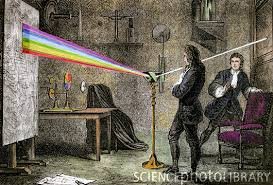Optics
Isaac Newton

Optics
In 1664, while still a student, Newton read recent work on optics and light by the English physicists Robert Boyle and Robert Hooke, he also studied both the mathematics and the physics of the French philosopher and scientist Ren? Descartes. He investigated the refraction of light by a glass prism, developing over a few years a series of increasingly elaborate, refined, and exact experiments, Newton discovered measurable, mathematical patterns in the phenomenon of colour. He found white light to be a mixture of infinitely varied coloured rays (manifest in the rainbow and the spectrum), each ray definable by the angle through which it is refracted on entering or leaving a given transparent medium. He correlated this notion with his study of the interference colours of thin films (for example, of oil on water, or soap bubbles), using a simple technique of extreme acuity to measure the thickness of such films. He held that light consisted of streams of minute particles. From his experiments he could infer the magnitudes of the transparent corpuscles forming the surfaces of bodies, which, according to their dimensions, so interacted with white light as to reflect, selectively, the different observed colours of those surfaces.
The roots of these unconventional ideas were with Newton by about 1668, when first expressed (tersely and partially) in public in 1672 and 1675, they provoked hostile criticism, mainly because colours were thought to be modified forms of homogeneous white light. Doubts, and Newtons rejoinders, were printed in the learned journals. Notably, the scepticism of Christiaan Huygens and the failure of the French physicist Edm? Mariotte to duplicate Newtons refraction experiments in 1681 set scientists on the Continent against him for a generation. The publication of Opticks, largely written by 1692, was delayed by Newton until the critics were dead. The book was still imperfect. the colours of diffraction defeated Newton. Nevertheless, Opticks established itself, from about 1715, as a model of the interweaving of theory with quantitative experimentation.
 Effect on religious thought
Effect on religious thought Intended to become a minister
Intended to become a minister Biography
Biography Death
Death Laws of motion
Laws of motion Royal Opposition
Royal Opposition Enlightenment philosophers
Enlightenment philosophers Historical and chronological studies
Historical and chronological studies Introduction
Introduction Publications
Publications Royal Mint
Royal Mint Mathematics
Mathematics Test your English Language
Test your English Language  Photography Essentials
Photography Essentials Tips to get ready for Work
Tips to get ready for Work Healthy Lips
Healthy Lips Grandparents Day Celebration
Grandparents Day Celebration Tips to succeed in Business
Tips to succeed in Business What to Eat in Manipur
What to Eat in Manipur International Sport Events
International Sport Events Greatest Concept Cars Ever
Greatest Concept Cars Ever




